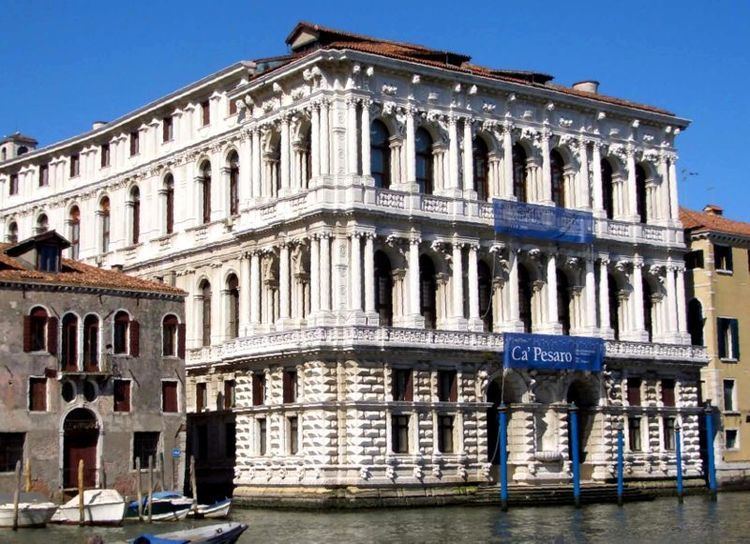Established 1902 (1902) Website capesaro.visitmuve.it Province Province of Venice Architect Baldassare Longhena | Director Silvio Fuso Opened 1710 Phone +39 041 524 0695 | |
 | ||
Location Santa Croce 2076,
30135 Venice, Italy Type Art museum, Historic site Address Santa Croce, 2076, 30135 Venezia, Italy Hours Closed now Sunday10AM–6PMMondayClosedTuesday10AM–6PMWednesday10AM–6PMThursday10AM–6PMFriday10AM–6PMSaturday10AM–6PM Artwork Judith II, Sewing the Sail, The Praying Jew, Still life (vases and bottles), Nude Similar Ca' Rezzonico, Ca' d'Oro, Museo Correr, Museo di Palazzo Mocenigo, Fondazione Musei Civici di V Profiles | ||
Ca pesaro galleria internazionale d arte moderna
The Ca' Pesaro is a Baroque marble palace facing the Grand Canal of Venice, Italy. Originally designed by Baldassarre Longhena in the mid-17th century, the construction was completed by Gian Antonio Gaspari in 1710. As at Longhena's Ca' Rezzonico, a double order of colossal columns and colonnettes flanking arch-headed windows, reinterpreting a motif of Jacopo Sansovino, Longhena creates the impression of double loggias extending across the main Grand Canal frontage, above a boldly rusticated basement. Today it is one of the 11 museums run by the Fondazione Musei Civici di Venezia system.
Contents
- Ca pesaro galleria internazionale d arte moderna
- Ca pesaro
- The building
- Modern Art Museum
- Oriental Art Museum
- References
Ca pesaro
The building
The palace was built in the second half of the 17th century for the noble and wealthy Pesaro family, a project by the Venetian architect, Baldassarre Longhena, who also designed the church of the Salute and Ca' Rezzonico. Works began in 1659 starting from the landside; the courtyard was completed by 1676. By 1679, the façade on the Grand Canal had already reached the second floor, but when Longhena died 3 years after, the palace was still unfinished. The Pesaro family then entrusted its completion to Gian Antonio Gaspari who concluded it in 1710, according to the original project. Longhena was inspired by Sansovinian classicism when designing Ca’ Pesaro, creating expressions of a new and sumptuous harmony, with its complex and powerful composition, yet well-balanced. The Sansovinian motif is more explicit on the first floor, with the chiaroscuro rhythm of the arches and columns. On the second floor, the façade is enriched by ornamentation in the pendentives and the entablatures. The entrance-hall, laid out along the axis of the entire building, contrasts with the clarity of the courtyard, articulated around the monumental well and enclosed by a terrace and an ashlar-arcade. The palace still conserves some of the fresco and oil decorations of the ceilings by artists such as Bambini, Pittoni, Crosato, Trevisani and Girolamo Brusaferro. The collections of the Pesaro family, as documented in the archives, must have been even more remarkable, including works by artists such as Vivarini, Carpaccio, Bellini, Giorgione, Titian, Tintoretto, as well as other famous Venetian artists of the 17th and 18th centuries. This great heritage was completely dispersed by 1830, the year of the death of the last Pesaro family member, who auctioned most of the collection in London. The palace was passed on firstly to the Gradenigo family and then to the Armenian Mechitarist Fathers, who used it as a college. It was finally bought by the Bevilacqua family, and became the property of Duchess Felicita Bevilacqua La Masa. It was she who decreed the present usage of the building, bequeathing it to the city in 1898, as a museum of Modern Art.
In 1902, thanks to the bequest of the Duchess, the City Council decided to use the palace to host the Modern Art municipal collection, which had been started in 1897, when the second Venice Biennale was held. Shortly afterwards, between 1908 and 1924, it also was used to host the Bevilacqua La Masa exhibitions, which, in lively contrast with the Venice Biennale, favored a generation of young artists, including Boccioni, Casorati, Gino Rossi, Juti Ravenna and Arturo Martini. The collection was enriched over the years by further acquisitions and donations.
Modern Art Museum
Ca' Pesaro houses 19th and 20th century collections of paintings and sculptures, as well as a section on graphic art.
Oriental Art Museum
The upper floor is dedicated to the Oriental Art Museum, housing some 30,000 objects, mainly from Japan (armoury, inros, netsukes, paintings by Koryusai, Harunobu, Hokusai, etc.), but also from China and Indonesia. This collection of oriental objects was brought back from a stay in Asia by Prince Henry of Bourbon-Parma, Count of Bardi, at the end of the 19th century, and bequeathed to the Italian state.
